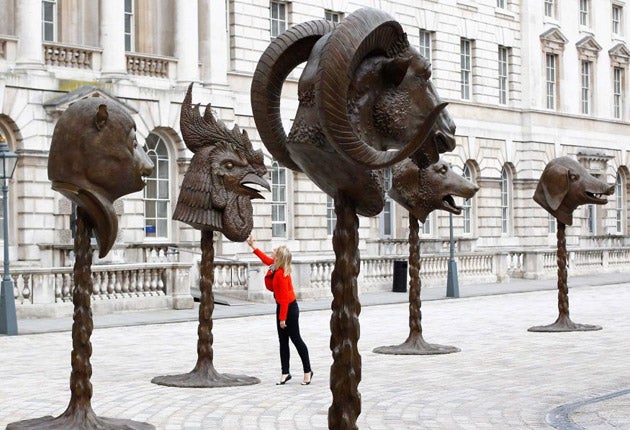Circle of Animals, Somerset House, London<br/>Ai Weiwei, Lisson Gallery, London
Chinese sculptor Ai Weiwei is eloquent, even when held by his government, in two UK shows

Rat, rooster, fox, dragon: which is the odd one out? The answer, of course, is fox.
All the others are real, at least if you are a Chinese astrologer or Ai Weiwei. Do a quick headcount of Ai's Circle of Animals – bronze busts of zodiacal creatures, arranged in a semi-circle outside Somerset House – and you find yourself brought up short. Rat, rooster, dog, dragon ... Dragon? The Chinese believe in dragons? Where is Kipling when you need him?
The Chinese also believe in other things that we do not, notably in beating up dissidents and holding them without trial. (Let us forget, for the moment, about Guantanamo Bay.) Ai, as you will have read, has suffered both of these injustices – is, at the time of writing, still suffering the second. It is both easy and difficult to see why.
When I went to his compound in Beijing last year, I found a pair of locked gates spray-painted with a trademark Ai symbol – a middle finger, raised at would-be visitors in a gesture that means "fuck off" in Chinese, as in English. Scrolling down the photographs on Ai's website, you find that he has carefully filled in the credit slots with the words "fuck off", as though they were his name. You can't help feeling a little taken aback, an emotion shared by the Chinese authorities.
Which leaves us with a number of critical headaches. Given all of this, how are we to see Ai? As a political artist, or as a performance artist whose act includes routine beatings about the head? Ai is a brave man, and an unfortunate one: but is he also a good artist? Can those two questions be separated? So what I would like to do – what I'm going to do – is to do Ai the courtesy of reviewing his London shows as art rather than as politics.
If one thing links his animal heads with his work at the twin Lisson Galleries (and with his Sunflower Seeds, to be reshown, in a cone, at Tate Modern in early June), it is their craftedness. Ai's art is crafted to an almost perverse degree, and not just when compared with the generally deskilled run of Western contemporary art.
Each of his hundred million sunflower seeds was made by hand at an ex-imperial porcelain factory in Jingdezhen: I forget the precise statistics, but their production took over the city's entire output for months. The titular creatures in Circle of Animals – the dragon in particular – are classic, complex cast-bronze figurines blown up to monstrous size. The pair of untitled buckminsterfullereens in an upstairs space at the Lisson are inlaid in huali wood, their exquisite joins made without nails or screws. Marble Doors is exactly what it says it is: 20 traditional Chinese doors hand-carved in white marble and stacked in the Lisson's backyard.
When I reviewed Sunflower Seeds last October, I compared the grandeur of their ordering with Mao's injunction to let a hundred flowers bloom. Mao's suggestion was, of course, a lightly-disguised command; Ai's was a commission. The second order was paid for and could have been turned down; not so the first. Still, there was implicit in the making of Sunflower Seeds something imperial, something magnificent and possibly wanton. And intentionally so.
If, as an artist, you set out to engage with a bad system and a bad history, there are two ways to go. You can make art that refuses to have anything to do with that history and system, or you can make art that confronts them on their own terms. The vast, Teutonic canvases of Anselm Kiefer deal with the problems of German-ness by being German. Likewise, Ai's art sets out to be, and succeeds in being, Chinese. That is not to say that it loses power in translation. East may be East, and West West, but the balance between the state and the individual is timeless and universal.
So to see Ai, left, as a political artist is to limit him. His importance is much greater. He is, in the widest sense, a moralist and a humanist. And yes, he is a very, very good artist. Part of his courage lies in putting himself on the line, in taking a complex thing such as a carved wooden door and having it recarved in marble just because you can; then having 20 of them stacked up in a gallery yard as though they were so much old lumber. Artists, like party members, are powerful people; it takes a very brave artist to say it. I hope the Chinese let Ai go soon.
Next Week:
Charles Darwent gets explicit with Tracey Emin at the Hayward Gallery
Art Choice
Tate Modern's Miro exhibition shows the political in the Spanish Surrealist's whimsical works (till 11 Sep). Heracles to Alexander the Great is the Ashmolean in Oxford's summer blockbuster, with a huge collection of objects from newly found royal tombs of the Kingdom of Macedon, in ancient Greece (till 29 Aug).
Join our commenting forum
Join thought-provoking conversations, follow other Independent readers and see their replies
Comments
Bookmark popover
Removed from bookmarks